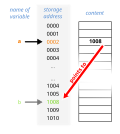Modula-2 is a structured, procedural programming language developed between 1977 and 1985/8 by Niklaus Wirth at ETH Zurich. It was created as the language...
33 KB (3,472 words) - 10:08, 27 May 2025
concentrated his efforts on Modula's successor, Modula-2. Modula-2 Modula-2+ Modula-3 Wirth, Niklaus (1 January 1976). "Modula: a language for modular multiprogramming"...
3 KB (166 words) - 00:41, 27 December 2024
Modula-3 is a programming language conceived as a successor to an upgraded version of Modula-2 known as Modula-2+. It has been influential in research...
35 KB (3,911 words) - 20:38, 27 July 2025
Modula-2+ is a programming language descended from the Modula-2 language. It was developed at DEC Systems Research Center (SRC) and Acorn Computers Ltd...
5 KB (363 words) - 09:54, 27 May 2025
Lilith (computer) (redirect from Modula Computer Systems)
and a computer networking interface. Its software is written fully in Modula-2 and includes a relational database program named Lidas. The Lilith processor...
10 KB (710 words) - 23:36, 6 July 2025
(1966), ALGOL W (1966), Pascal (1970), Modula (1975), Modula-2 (1978), Oberon (1987), Oberon-2 (1991), and Oberon-07 (2007). He was also a major part...
28 KB (2,280 words) - 03:35, 22 June 2025
ARX was an unreleased Mach-like operating system written in Modula-2+ developed by Acorn Computers Ltd in the Acorn Research Centre (ARC) United Kingdom...
7 KB (603 words) - 10:11, 21 July 2025
Pointer (computer programming) (section Modula-2)
calls. Modula-2 is even more strongly typed than Pascal, with fewer ways to escape the type system. Some of the variants of Modula-2 (such as Modula-3) include...
72 KB (9,654 words) - 12:42, 19 July 2025
Type safety (section Modula-2)
(1985). Programming in Modula-2. Springer Verlag. "The Separation of Safe and Unsafe Facilities". Retrieved 24 March 2015. "ISO Modula-2 Language Reference"...
28 KB (3,647 words) - 10:03, 29 July 2025
Alto developed at Xerox PARC. The Modula-2-based Kronos was quite amenable to the basic principles of MARS, as Modula-2 is fundamentally modular, allowing...
11 KB (1,068 words) - 16:26, 17 March 2024
Guidelines, Krzysztof Cwalina, Brad Abrams Page 62] Modula-2 Name Convention "Foreign API Identifiers in Modula-2 Name Convention". Archived from the original...
37 KB (3,883 words) - 13:59, 25 July 2025
ALGOL W Euler Modula Modula-2, Modula-3, variants Obliq Modula 3 variant Oberon (Oberon, Oberon-07, Oberon-2) Component Pascal Oberon-2 Pascal Object...
91 KB (6,709 words) - 16:48, 31 July 2025
where they used their experience with Mesa in the design of Modula-2+, and later of Modula-3. Mesa was a strongly typed programming language with type-checking...
14 KB (1,575 words) - 13:53, 9 June 2025
Power Fx MIIS MIMIC Mirah Miranda MIVA Script ML Model 204 Modelica Modula Modula-2 Modula-3 Mohol Mojo MOO Mortran Mouse MPD MSL MUMPS MuPAD Mutan Mystic...
28 KB (1,336 words) - 12:48, 4 July 2025
were later developed for Objective-C, Objective-C++, Fortran, Ada, Go, D, Modula-2, Rust and COBOL among others. The OpenMP and OpenACC specifications are...
57 KB (5,136 words) - 18:23, 31 July 2025
ORCA/Modula-2 is a Modula-2 compiler written in the Modula-2 programming language for the Apple IIGS computer. It was developed by Peter Easdown during...
3 KB (196 words) - 11:53, 29 April 2025
Windows platform. Extensions to the Pascal concepts led to the languages Modula-2 and Oberon, both developed by Wirth. Much of the history of computer language...
70 KB (8,514 words) - 19:00, 25 June 2025
Oberon (programming language) (category Modula programming language family)
(Euler, ALGOL W, Pascal, Modula, and Modula-2). Oberon was the result of a concentrated effort to increase the power of Modula-2, the direct successor of...
24 KB (2,427 words) - 23:07, 29 July 2025
TopSpeed. JPI first launched an MS-DOS compiler named JPI Modula-2, which later became TopSpeed Modula-2, and followed up with TopSpeed C, TopSpeed C++, and...
39 KB (4,177 words) - 13:15, 28 July 2025
base types, read-only field export, and reintroduces the FOR loop from Modula-2. It was developed in 1991 at ETH Zurich by Niklaus Wirth and Hanspeter...
22 KB (2,199 words) - 21:22, 27 May 2025
original Modula in its successor, Modula-2 (1978), which influenced later languages, particularly through its successor, Modula-3 (1980s). Modula's use of...
14 KB (1,761 words) - 00:15, 1 August 2025
Ritchie while he was working at Bell Laboratories. Wirth went on to design Modula-2 and Oberon. For the needs of the United States Department of Defense, Jean...
33 KB (3,629 words) - 12:55, 17 June 2025
like const and procedure to uppercase. This change made PL/0 resemble Modula-2 more closely. At the same time, Wirth's friend and collaborator C. A. R...
11 KB (1,314 words) - 12:05, 18 July 2025
report provided sub-modules, which make Fortran modules more similar to Modula-2 modules. They are similar to Ada private child sub-units. This allows the...
105 KB (11,249 words) - 01:45, 19 July 2025
(use .GE or 'GE'). Including ALGOL, Simula, Modula-2, Eiffel, SQL, spreadsheet formulas, and others. Modula-2 also recognizes # Including C, C++, C#, Go...
28 KB (2,852 words) - 09:18, 15 July 2025
to the calling one. Similar syntax is used in other languages including Modula-2 and Python. In Pascal there is no return statement. Functions or procedures...
20 KB (2,186 words) - 08:34, 20 December 2024
Standards Association (ASA). 1963-06-17. Wirth, Niklaus (1988). Programming in Modula-2 (PDF). doi:10.1007/978-3-642-83565-0. ISBN 978-3-642-83567-4. "Cambridge...
27 KB (2,579 words) - 11:49, 5 August 2025







